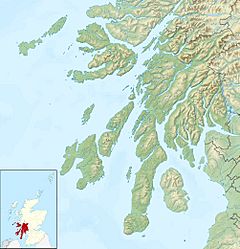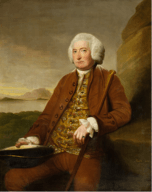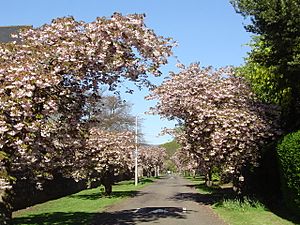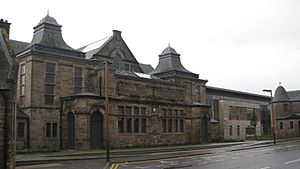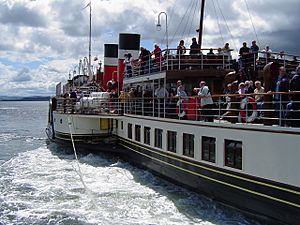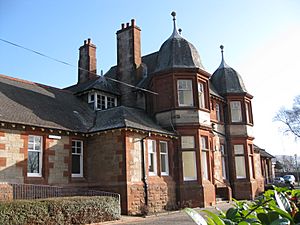Helensburgh facts for kids
Quick facts for kids Helensburgh
|
|
|---|---|
| Town and former burgh | |
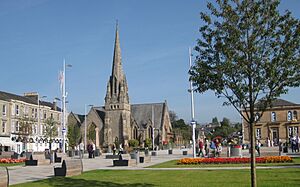 Colquhoun Square, showing plinths for the Outdoor Museum |
|
| Area | 5.24 km2 (2.02 sq mi) |
| Population | 13,230 (2020) |
| • Density | 2,525/km2 (6,540/sq mi) |
| OS grid reference | NS298833 |
| • Edinburgh | 61 mi (98 km) E |
| • London | 363 mi (586 km) SSE |
| Council area | |
| Lieutenancy area | |
| Country | Scotland |
| Sovereign state | United Kingdom |
| Post town | HELENSBURGH |
| Postcode district | G84 |
| Dialling code | 01436 |
| EU Parliament | Scotland |
| UK Parliament |
|
| Scottish Parliament | |
Helensburgh (/ˈhɛlənzbərə/ HEL-ənz-BƏR-ə; Scottish Gaelic: Baile Eilidh) is a town in Scotland. It sits on the north side of the Firth of Clyde, right where the Gareloch meets the sea. Long ago, it was part of Dunbartonshire. But since 1996, it has been part of Argyll and Bute.
Contents
Helensburgh's Story
How Helensburgh Began
People have found old remains in the Helensburgh area. These show that people lived here even before recorded history. The oldest building in the town is Ardencaple Castle. This castle was the home of the Clan MacAulay and might be as old as the 1100s. Today, only one tower of the castle is left. The rest was taken down between 1957 and 1959.
In 1752, Sir James Colquhoun bought the land where Helensburgh now stands. Back then, it was called Malig or Milligs. In 1776, he tried to sell parts of the land for building. He especially wanted to attract people who made hats, stockings, and cloth. But his plan did not work well. The roads were very basic, and the shallow, rocky shoreline made it hard for ships to land.
The town got its new name, Helensburgh, around 1785. Sir James decided to name it after his wife, Lady Helen Sutherland. For a few years, people used both the old and new names. Some even called it the New Town. The town's coat of arms uses symbols from both the Colquhoun and Sutherland families.
Helensburgh officially became a burgh in 1802, thanks to King George III. This was a bit surprising because, in 1799, only about 100 people lived there. To celebrate its 200th birthday in 2002, many people from Helensburgh Heritage Trust wrote a special history book about the town.
Henry Bell came to Helensburgh by 1806. He was a skilled builder and also worked in shipyards. He likely designed the Baths Inn, which he and his wife ran as a hotel. He also designed other buildings. The Baths Inn later became the Queen's Hotel and is now private homes.
The Comet Steamship
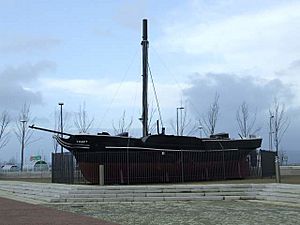
In those days, people believed that taking baths was good for their health. Because of Henry Bell's ideas, Helensburgh started to become a popular holiday spot. Bell was also the town's first Provost (like a mayor) from 1807 to 1809.
When Henry Bell arrived, the roads to Glasgow were in bad shape. A boat trip could take days, depending on the wind and tides. So, in 1812, Henry Bell launched the paddle steamer Comet. This ship brought guests from Glasgow to his hotel much faster and more comfortably. The Comet was the first commercial steamship in Europe.
Because steamships could travel against the wind, Helensburgh's shallow shore was no longer a big problem. The town grew quickly, from about 500 people in 1810 to 2,229 by 1841. Henry Bell was very important for Scotland's economy. He helped start tourism and played a big part in the River Clyde becoming famous for shipbuilding.
The Railway Arrives

When the Glasgow, Dumbarton and Helensburgh Railway arrived in 1858, Helensburgh's population grew even faster. By 1871, it had 5,964 people. The Municipal Buildings, designed by John Honeyman, were finished in 1879.
Glasgow was growing fast as an industrial city, but it became dirty and smoky. The railway meant that richer business people from Glasgow could live in the fresh air of Helensburgh. They could travel to work each day. This led to the town expanding northwards up the hill. Many large Victorian houses were built. The most famous is The Hill House, designed in 1902–03 by architect Charles Rennie Mackintosh. It now belongs to the National Trust for Scotland. These parts of town are laid out in a grid pattern, making Helensburgh an early example of a planned town in Scotland.
In 1960, the railway line from Helensburgh Central to Glasgow Queen Street was electrified. New "Blue Trains" offered faster, regular services. This helped traffic on the route grow. From October 2010, two trains an hour started running all the way to Edinburgh.
By the late 1870s, the North British Railway Company felt their steamer services were at a disadvantage. Passengers had to walk from Helensburgh Station through town to the pier. Their rivals had stations right next to their piers. So, the North British wanted to extend the railway line through the town centre to the pier.
This idea caused a big debate in town, and Parliament decided against it. So, the North British Railway Company built a "station in the sea" at Craigendoran, just outside Helensburgh. This station opened in 1882. Shipping services stopped in 1972, but Craigendoran railway station is still used. In 1894, the West Highland Railway opened from Craigendoran to Fort William. A new station, Helensburgh Upper, was built. This new railway did not change the town's population much. But it did change its look with a large embankment and deep cutting.
Helensburgh's war memorial in Hermitage Park lists 205 men and 1 woman who died in World War I. In 2020, a project found 59 more "missing names." If you look at the 1911 population of 8,529, Helensburgh lost three percent of its people to the war. Many more suffered serious injuries.
When World War II started in 1939, the British Government worried about German bombing of ports in southern England. So, they built two military ports in Scotland. Military Port Number 1 opened in 1941 at Faslane on the Gareloch, 5 miles (8 km) from Helensburgh. A railway linked Faslane to the West Highland Line. Huge amounts of wartime supplies and troops moved through Faslane. Many areas around Helensburgh were used by British and American forces for war activities.
After the war, Faslane was split. The southern half was used by the Royal Navy. The northern half was used for breaking up ships until 1980. In 1957, the Royal Navy moved its submarine base from Rothesay Bay to Faslane. Six years later, the British Government decided to buy nuclear weapons from the United States. These were based on submarines at Faslane, which became known as the Clyde Submarine Base. This greatly affected Helensburgh, especially with new homes for naval staff. The town's population grew to 15,852 by 1991. Since 1996, surface ships have also been based there. The official name changed to Her Majesty's Naval Base Clyde.
Modern Helensburgh
In 1971, Helensburgh got its first conservation area, protecting The Hill House and Helensburgh Upper Station. More conservation areas were added in 1994 and 2019, protecting the town's special buildings and history.
In 2006, Helensburgh was found to be the second most expensive town in Scotland to buy a house.
The town has many streets lined with trees. The cherry blossom trees in spring are especially beautiful. Because of its many trees, Helensburgh is sometimes called "the Garden City of the Clyde." In 2016, the Helensburgh Tree Conservation Trust joined The National Tree Collections of Scotland. This was because of the amazing variety and quality of its street trees. No other Scottish town had received this honor.
In 2015, Colquhoun Square was redesigned. This project also included the west esplanade. A key part of the redesign was the Outdoor Museum. It has 120 stands that will slowly be filled with items from Helensburgh's history. These include a puppet's head used by John Logie Baird in his first television tests. Also, the ship's bell from Henry Bell's paddle steamer Comet is there. Brass plaques in the pavements describe what the town's streets were like in 1845.
That same year, the old Clyde Street School reopened as the Helensburgh and Lomond Civic Centre. This happened after big renovations and the addition of a new wing and public cafe. You can see displays from the Helensburgh Heritage Trust there.
The Tower Digital Arts Centre is in the old St Columba Church on Sinclair Street. In 2016, it became a cinema and arts centre for the town.
The West King Street Hall next door became the Scottish Submarine Centre two years later. The Centre now has the last Stickleback-class submarine built for the Royal Navy in 1955.
In 2016, it was confirmed that a building long thought to be by Charles Rennie Mackintosh was indeed his work. It was built as the Helensburgh & Gareloch Conservative Club. The top floor is now known as the Mackintosh Club. It is at 40 Sinclair Street in the town centre.
Three years later, Mackintosh's other work, the Hill House, was covered by a special protective structure called "The Box." This was to help the building dry out and prevent damage from dampness. The Box has cool chainmail mesh walls and walkways. These let visitors see the Hill House's outside from high up.
In June 2021, a pavilion was added to Hermitage Park. This finished a four-year project. The Park Pavilion is a Passivhaus design, meaning it is very energy efficient. It is thought to be the first non-home Passivhaus building in Scotland.
In October 2022, a new £22 million leisure centre opened on Helensburgh pier. It replaced the old swimming pool, which had closed two months before.
Helensburgh's Location and Land
Helensburgh is about 25 miles northwest of Glasgow. The town faces south across the Firth of Clyde towards Greenock. The Firth of Clyde is about 3 miles wide here. Big ships can dock at Greenock, but Helensburgh's shore is very shallow. However, the Gareloch to the west of town is deep.
Helensburgh is located at the western end of the Highland Boundary Fault. This means the hills north of Helensburgh are in the Highlands. The land south of Helensburgh is in the Lowlands or Central Belt of Scotland. So, the area around Helensburgh has many different types of landscapes. For example, Loch Lomond (part of Scotland's first National Park) is only 4 miles over the hill to the north-east. The Highland Boundary Fault is not active, but very small earthquakes sometimes happen here.
During the last ice age, the heavy ice pushed the land down. When the ice melted, sea levels were higher than they are now. You can see proof of this in Helensburgh. The first two blocks of streets near the sea are built on a raised beach. Behind them, the land rises steeply for one block, then more gently. This is an old sea cliff that has worn away. The land, now free of the ice's weight, is slowly rising. The small local earthquakes show this.
You can see more proof of the last ice age at low tide. The beach has large rocks called glacial erratics. These rocks were carried from far away inside the glaciers. They were dropped in their current spots when the glaciers melted.
Weather in Helensburgh
Helensburgh has an oceanic climate. This means it has mild temperatures and rain throughout the year.
| Climate data for Helensburgh (0 m asl, averages 1991–2020) | |||||||||||||
|---|---|---|---|---|---|---|---|---|---|---|---|---|---|
| Month | Jan | Feb | Mar | Apr | May | Jun | Jul | Aug | Sep | Oct | Nov | Dec | Year |
| Mean daily maximum °C (°F) | 6.6 (43.9) |
6.9 (44.4) |
8.5 (47.3) |
11.2 (52.2) |
14.4 (57.9) |
16.5 (61.7) |
18.0 (64.4) |
17.6 (63.7) |
15.5 (59.9) |
12.0 (53.6) |
9.0 (48.2) |
6.8 (44.2) |
11.9 (53.5) |
| Mean daily minimum °C (°F) | 1.4 (34.5) |
1.2 (34.2) |
2.1 (35.8) |
3.7 (38.7) |
5.9 (42.6) |
8.9 (48.0) |
10.8 (51.4) |
10.7 (51.3) |
8.8 (47.8) |
6.0 (42.8) |
3.6 (38.5) |
1.4 (34.5) |
5.4 (41.7) |
| Average rainfall mm (inches) | 180.0 (7.09) |
150.7 (5.93) |
137.1 (5.40) |
87.1 (3.43) |
85.2 (3.35) |
99.1 (3.90) |
112.1 (4.41) |
131.2 (5.17) |
133.2 (5.24) |
172.3 (6.78) |
165.7 (6.52) |
189.1 (7.44) |
1,642.8 (64.66) |
| Average rainy days (≥ 1 mm) | 18.9 | 16.8 | 15.7 | 13.8 | 13.0 | 14.2 | 14.9 | 16.2 | 15.3 | 17.9 | 19.2 | 18.4 | 194.3 |
| Mean monthly sunshine hours | 36.7 | 63.6 | 97.2 | 143.6 | 187.5 | 141.1 | 143.1 | 141.6 | 109.9 | 77.8 | 50.6 | 32.6 | 1,225.3 |
| Source: Met Office | |||||||||||||
Getting Around Helensburgh
The town has three railway stations: Helensburgh Central, Craigendoran, and Helensburgh Upper. Helensburgh Central and Craigendoran are on the North Clyde Line. Helensburgh Central is the end of the line. Helensburgh Upper is on the West Highland Line and is used by the Caledonian Sleeper train.
Helensburgh also has many buses. These connect the town to Glasgow, the Vale of Leven, and Carrick Castle.
A special local way to travel is on the paddle steamer Waverley. It used to visit Helensburgh pier in the summer. It is known as the last sea-going paddle steamer in the world. It was launched in 1946 for service from Craigendoran pier. However, Craigendoran pier is now old and unused. Services stopped in 1972. Helensburgh pier was closed to all boats in late 2018 because it was in bad condition. So, it is not known when the "Waverley" will be able to visit again.
People of Helensburgh
Population and Jobs
In 2022, about 13,230 people lived in Helensburgh. Today, many people who live in Helensburgh travel to Glasgow for work. Helensburgh is also a main shopping area for the local region and for tourists. The Clyde Naval Base at Faslane on the Gareloch also affects the town. This base is home to the United Kingdom's submarine fleet and their nuclear weapons. It is also a major employer in the area.
Churches and Faith
Most major Scottish Christian denominations have churches in Helensburgh. The biggest was the Church of Scotland. By 1880, it had five churches in town. But as fewer people attended church, these churches joined together by 2015. Now, the only Church of Scotland church is Helensburgh Parish Church in Colquhoun Square. Helensburgh has the largest Church of Scotland Parish in Scotland.
The Scottish Catholic Church is also important in the town. It has a church called St Joseph's on Lomond Street. St Joseph's church hall was the original parish church in Helensburgh.
St. Michael and All Angels Church is the town's only Category A listed church. This means it is a very important historic building. This church for the Scottish Episcopal Church was designed in 1868 by Sir Robert Rowand Anderson.
Schools and Learning
Helensburgh has seven schools.
There are three state primary schools: Colgrain, John Logie Baird, and Hermitage Primary. These schools prepare students for Hermitage Academy, the town's state secondary school. Helensburgh also has a Roman Catholic state primary school called St. Joseph's.
Parklands School is for students with special educational needs. It is a purpose-built school provided by Argyll and Bute Council. Ardlui House, on the school grounds, offers short stays for these children and young people.
Lomond School is the only private school. It started in 1977 when St Bride's School (for girls) and Larchfield School (a primary school for boys) joined together. Lomond School offers both primary and secondary education. It has both day students and boarders, many of whom come from other countries.
Healthcare
The town has two doctor's offices, both in the same Medical Centre on East King Street. There are also several dentists and eye doctors.
The Victoria Integrated Care Centre was once the Victoria Infirmary. It no longer has patients staying overnight. The original building is not used much now. However, various clinics are held in other buildings on the grounds.
In 2006, the Helensburgh area chose to be part of the NHS Highland health board, which is based in Inverness. But because Inverness is far away, NHS Highland works with NHS Greater Glasgow and Clyde. This makes sure that local services are provided.
Sports and Fun Activities
Helensburgh has many sports clubs. These include football, rugby, cricket, athletics, netball, hockey, curling, bowling, golf, sailing, and fishing clubs. The seafront has an indoor swimming pool, a walking path, shops, cafes, pubs, and sailing facilities. This includes the Helensburgh Sailing Club.
Helensburgh hosts several yearly events. The local Round Table group puts on an annual fireworks display for Guy Fawkes Night. They also host a Real Ale Festival. The Helensburgh & Lomond Highland Games happen every year around early June.
For arts, Helensburgh has The Tower Digital Arts Centre. It works as a cinema and also hosts live music and theatre shows.
There are many walking paths in and around Helensburgh. It is also the starting point for some long-distance walks and kayaking trips. In town, you can walk in the Duchess Woods, which is Argyll & Bute's only local nature reserve.
A longer walking path is the Three Lochs Way. It connects Loch Lomond with Helensburgh, the Gareloch, and Loch Long. This path is 34 miles (55 km) long.
The longest walk starting locally is the John Muir Way. This path honors John Muir, who is famous as the "Father of National Parks." It runs from Helensburgh for 134 miles (215 km) to his birthplace at Dunbar in East Lothian.
The Clyde Sea Lochs Trail is a road route that starts in Dumbarton. It goes through Helensburgh, around the Rosneath Peninsula, and ends at Arrochar. There are information panels along the way.
The Argyll Sea Kayak Trail also starts at Helensburgh pier. It finishes at Oban, covering a distance of about 95 miles (150 km).
Other Facts About Helensburgh
Twin Town
Helensburgh has only one twin town: Thouars in France. They signed an agreement to be twin towns in 1983.
Famous People From Helensburgh
- W. H. Auden, poet
- John Logie Baird, invented the first working television
- Henry Bell, engineer and steamship pioneer
- Jack Buchanan, actor and singer
- Charlotte Cooper, Olympic Gold medal-winning tennis player
- A. J. Cronin, novelist
- Cecil Day-Lewis, famous poet
- James George Frazer, social anthropologist
- Sir James Guthrie, artist
- Deborah Kerr, actress, known for The King and I
- Charles Rennie Mackintosh, famous architect (designed The Hill House)
- Murdo MacLeod, football player and manager
- Moses McNeil, co-founder of Rangers F.C.
- Peter McNeil, co-founder of Rangers F.C.
- Bob McGregor, Olympic Silver medal-winning swimmer
- John Muir, famous conservationist, "Father of National Parks"
- Neil Munro, journalist and writer
- Gary Orr, golfer
- Luke Patience, Olympic Silver medal-winning sailor
- Gordon Reid, wheelchair tennis player
- Emma Richards, yachtswoman
- Walter Smith, football player and manager
- Tom Vaughan, film and television director
See also
 In Spanish: Helensburgh para niños
In Spanish: Helensburgh para niños


